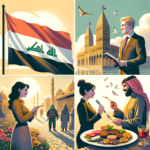Karbalā, Iraq: A Journey Through History and Culture
Karbalā, a city imbued with deep religious significance and historical value, attracts visitors seeking rich cultural experiences. Renowned as the site of the Battle of Karbalā in 680 AD, this city has become a pilgrimage destination for millions, particularly during the month of Muharram. Beyond its historical allure, Karbalā offers a vibrant local culture, bustling bazaars, and exquisite Islamic architecture that captivates the imagination of travelers.
The city’s most famous landmark, the Imam Husayn Shrine, is an architectural marvel and a testament to the city’s significance in Islamic history. Visitors can explore the serene atmosphere surrounding the shrine while engaging with the local community, known for its hospitality and warmth. Each corner of Karbalā narrates stories of resilience and faith, making it a must-visit destination for those interested in history.
When planning your visit, understanding the best time to visit Karbalā is crucial. The climate can vary significantly throughout the year, influencing the travel experience. This guide will provide insights into seasonal weather patterns, tourist seasons, and significant events that shape the ambiance of Karbalā.
When is the best time to visit Iraq?
The best time to visit Iraq, particularly Karbalā, is during the spring (March to May) and autumn (September to November). During these months, the weather is milder, with average temperatures ranging from 15°C to 25°C, creating comfortable conditions for exploration and sightseeing. Peak tourist activity often coincides with significant religious events, like Ashura, which draws pilgrims from around the world.
Tourist Seasons in Karbalā
- Peak Season: The peak season typically aligns with the months of Muharram and Safar, especially during Ashura, when thousands of pilgrims visit the Imam Husayn Shrine. The city becomes vibrant with religious activities, making it a bustling time for tourism.
- Mid Season: Spring and autumn months (March to May and September to November) see a steady flow of tourists, as the weather is pleasant and ideal for outdoor activities.
- Valley Season: Summer months (June to August) experience extreme heat, with temperatures often reaching above 40°C. This deters many tourists, making it a quieter time to visit, albeit less comfortable.
Weather Conditions & Seasonal Changes
Karbalā experiences a desert climate, characterized by hot summers and mild winters. Key weather details include:
- Average high temperatures:
- January: 15°C
- July: 40°C
- Average low temperatures:
- January: 5°C
- July: 25°C
- Average monthly precipitation: Generally low, with occasional rain in the winter months.
Special Festivities & Events
- Ashura: The most important event, commemorating the martyrdom of Imam Husayn, attracting millions of pilgrims.
- Ramadan: A month of fasting and prayer, creating a unique atmosphere in the city, with special evening prayers and community gatherings.
- Eid al-Fitr: Celebrated at the end of Ramadan with festive meals and gatherings.
- Eid al-Adha: Another significant holiday marked by prayers and celebrations.
- Local Markets (Souks): Active throughout the year, showcasing traditional crafts and local cuisine.
Conclusion
In summary, the best time to travel to Karbalā is during the spring and autumn months, when the weather is most inviting, and the city pulsates with cultural vibrancy. Whether you’re drawn by the rich history or the deep spiritual significance, Karbalā promises an unforgettable experience that will leave a lasting impression.


